The Pillars of Horror is a look at the games, past and present, that have shaped the genre, showcasing the various mistakes and triumphs that have come out over the years. They may not all be gems, but they’ve all contributed something to scaring the controllers out of people’s hands.
For console horror, Resident Evil is where it all began. It may not be the first, but it’s the game that put the genre in people’s minds. It was my first horror game, and it completely changed the way I looked at games. Having to count bullets while facing overwhelmingly strong enemies had my hands shaking. Wandering around empty hallways filled with dead ends and misleading paths kept me from ever feeling like I could get myself oriented. Returning to save points while limping and weak only to realize that I would soon have to step back into the fray quickly turned a game type I’d never heard of into my favorite genre.
This game does not screw around. You might think you’re starting to get a leg up on it, but it’s just biding its time; waiting to hit you so hard you’ll think you’re playing Ninja Gaiden. If you haven’t played it, you really don’t know what it means to count bullets. Scratch that, since you don’t even get a gun for your first fight with a zombie. Instead, you’re stuck with just your knife; which is the game’s way of showing you how it works while making it clear that if you only have this weapon, you’re screwed. How many times have you been killed by the first enemy in a game since you started playing video games? Maybe just that first goomba in Super Mario Bros? Well, Resident Evil stopped me cold at this guy until I broke down and ran away.
When you do get that gun, you’ll probably feel like you’re powerful. Fifteen bullets per pick up? You’re on top of the world; an unstoppable zombie-killing juggernaut. Once you realize it takes at least nine bullets to put a zombie down for good, that smile just crumbles. Once you see how many zombies there are between ammo pickups, your spirit will wither. Despite the cool firearms, this game is still about learning when it’s best to run away; which is all the time. Your supply of shots is always dwindling, but I swear the enemies never stop showing up.
Having zombies that were that strong meant even one of them showing up was cause for alarm. I’d have to take aim, wait to make sure the game’s auto-aim had targeted the zombie, and start to pump bullets into it. You’d have to be careful, as zombies tended to drop after a few hits, often resulting in a precious shot getting wasted on empty air. Once down, it’s hard to be sure that they’re dead, too. Downed zombies will sometimes just stay there for a long period of time as the game tries to fool you into coming close.
Sure, a pool of blood would always form under zombies that were completely dead, but sometimes you couldn’t be sure. Maybe you took your eyes off the downed zombie while fighting another? Maybe it happened just a little off-screen? Either way, you’d have to carefully make your way to the body to see if it got back up (hopefully not too close and giving the zombie a mouthful of your shin in the process), and then wait for it to get back up and shoot it again. Putting a second or third zombie in each room only added to the fun, creating some nerve-wracking moments that had you counting down the last of the bullets in your clip while the zombies kept methodically moving forward.
Once you get that shotgun you can feel that power again, though. The game’s not so scary once you can pop a zombie’s head off with one shot, is it? Don’t get used to it, because the game’s got even more tricks up its sleeve, and I’m not just talking about hunters. Through carefully crafting the mansion and by exercising complete control over your saving as well, the game manages to tighten the noose around your neck even harder once you think you’re getting stronger.
I was getting pretty confident while playing it a few days ago. I was beating bosses, I had a stockpile of ammo and healing items, and the hunters weren’t that much of a threat if I kept calm. I looked down at a hole that the game wanted me to go down, and I knew it was going to be a while before I got back to my item box to get at my stockpile. I figured it was no big deal. I could handle whatever the game threw at me.
The next section was long. Really long. It was full of softball monsters that I hadn’t had much trouble with. I wasn’t afraid of anything anymore, as I’d forgotten the ways that Resident Evil had been built to break its player base. Every shot I spent gleefully killing zombies was one less that I had to deal with other monster. Due to my own overconfidence in my abilities, I also hadn’t saved after beating a boss; meaning I had no healing items when I went in. I felt like I couldn’t be beaten, and that’s when all of the game’s tactics came together.
Saving in games tends to be a bothersome subject for me. I want to be able to save anywhere since I am typically pretty busy, and I hate holding out for checkpoints. Horror games are the exception, because being able to save is my safety net, my one balm against the terrible things that are happening. I only beat Fatal Frame because I could compulsively save my game after every enemy. Resident Evil is another story, because not only are the save points few and far between, but you need an ink ribbon to use them. That means having a finite amount of saves in the game, and while the game is fairly liberal with them, there’s this constant fear that I’ll run out of them before the game is over. If I saved like I usually would, I would be out of them within an hour. Having the system set up like that encouraged me to look at my inventory and take risks I probably shouldn’t have.
Inventory control was another key part of the problem. Like I said, limiting the amount of ink ribbons made me reluctant to save. Giving me only six inventory spots (eight if you’re Jill, you WIMP) meant that I had to carefully pick what I brought with me. I could have brought the pistol and shotgun with their ammo, but that was four of my slots. Bringing a health item for the boss brought that up to five, plus I needed the key to get into his room. I would have been full going in, and with the game’s item storage room being a long walk away I didn’t really want to go all the way back to fiddle with my inventory. I brought the shotgun and ammo, a healing item, and the key. That way, I could collect anything important I found along the way. That was especially important when I knew I was going down that hole. I didn’t want to have to backtrack a few hundred times to collect everything I needed.
So, poorly armed but full of confidence, I hopped in; and only by the greatest series of lucky movements did I return. By controlling my ammo and saves, the game forced me to undergo a grueling endurance run against the hunters that had filled the mansion. Every fight chipped away at the health I couldn’t recover, soon leaving me in a dangerous state with many rooms to go. My confidence shrivelled up as I tried to press on, hunters dogging my every step. Even when I hit familiar halls, I was still being chased by two hunters in almost every corridor. I was one hit from death for five unbearable minutes before I slammed the door of the safe room shut.
Short on everything from my run, I knew that I would soon have to go right back out there. I couldn’t handle it, and had to shut the game off for a few hours while I collected myself.
I hate a lot of these design choices most of the time. I can’t stand having to roam back and forth across the same hallways while I collect handfuls of items and bring them to their specific destinations, all while knowing I haven’t got quite enough inventory space for all of them. It drives me crazy to be unable to get to a save point without a five minute walk, and even then, that I’m going to be down one more ink ribbon because a friend showed up unexpectedly. I hate debating whether I want to waste a ribbon when I think I can survive an area, only to have aiming trouble with three enemies and then die; losing hours of progress.
These were conscious decisions that, when they all come together, can set the player up for some harrowing experiences. Even today, or perhaps especially today, it’s amazing to see the grand effects of a few small choices. Sure, they bother me as a player and I’m sure they’d bug any modern gamer, but they are extremely important for the game’s pacing and scares. It’s really nice to be able to go back to a time when games didn’t hold your hand to make sure you could beat the game. For Resident Evil, it was more important that the game be made frightening and stressful than palatable to a broad audience. Funny thing is, Resident Evil moved on to become a giant of a franchise because it worried more about creating a terrifying experience rather than a crowd-pleasing one.
This is how you do horror with guns. This has that helplessness I love. It has that constant danger that you never escape no matter how much you feel you have. It plays on human arrogance, toying with you just before it gets really hard. It’s also not afraid to just throw something at you, making you jump right out of your seat even if you’re staring right at your enemy. I still got startled the first time an enemy grabbed me, and I still almost dropped my controller when the dogs came through the window. The game’s ugly as sin these days, but everything that made it so groundbreaking when it came out is still valid and functional today.
Every horror game owes something to Resident Evil – Every last one of them. If you haven’t played it, go do it right now. Get the Gamecube remake if you have to. Whatever you do, make sure you experience the dawn of console horror for yourself.
Images courtesy of yugiohforums.com, thocp.net.










